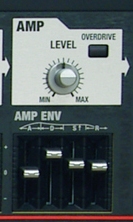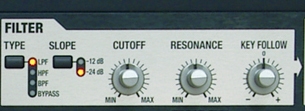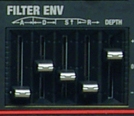Good day all,
Here we are, the final assignment. This has been a really great experience for me and I hope you can say the same. Good luck on the final exam!!
Lets do this!!!
I will be discussing the 5 most important synthesis modules: Oscillator, Filter, Amplifier, Envelope and LFO. To do this I will be using examples from the Synthesiser I use: the Roland SH-201.

One of the first things you may notice is just how well laid out this synth is. Lets take a closer look.


As you can see the layout shows clearly how the signal can be manipulated and in what order. First you create the sound with the Oscillator, then you select how you want to mix it, and what modulation you wish to add. After this you apply a filter, set amp level and envelope settings and finally some effects to enhance your sound. I would like to say that this is the reason I chose this synth but when I bought it I was exceptionally ignorant and just wanted a way to play Jump by Van Halen. I think I lucked out as I am a beginner and this course coupled with the layout of this synth has really helped me get so much more out of it.
I will discuss this topic under the following headings:
- Oscillator
- Filter
- Amp
- Envelope
- LFO
Oscillator
In synthesis the oscillator is slightly different from those used in other applications such as mixing boards. They are sometimes called “Voltage Controlled Oscillators” and are designed to move over time. We see that this synth has two Oscillators, which isn’t really important for this assignment but it is cool to play around with them. The Oscillator creates the sound based on a geometric waveform. We can see in the wave section on this synth are as follows
- Sawtooth
- Square
- Pulse wave
- Triangle
- Sine
- Noise
- Feedback Oscillator
- Super Saw
- Ext in
All of these wave shapes have different characteristics and can be modulated over time in terms of frequency and pitch. Some other options on this synth are Detune and PW/Feedback.
Detune: makes fine adjustments in pitch (Finer than that of the pitch knob). It can be used to create subtle differences in pitch between the two oscillators to make a fuller tone, similar to a chorus effect.
PW/Feedback: manipulates characteristics of three of the above wavelengths: Pulse wave, Feedback Osc and Super saw.
Filter
The next section we have is the filter. This is basically where we decide how bright and
substantial our sound is going to be. On the Sh 201 we start by selecting the type of filter we want.
- Low pass Filter: This is the most commonly used filter. It allows the lower frequencies to pass through.
- High pass Filter: This cuts the lower frequencies and emphasises the high end frequencies.
- Band pass FIlter: This only allows sounds within the cutoff range to pass through.
- Bypass: Bypasses the filter and leaves the signal untouched.
Next we have the slope. This determines how steep the filter is. Using the -12db slope will allow some of the frequencies above and below the cutoff frequency to get through, creating a gentler tone. The -24db slope is much steeper and will only allow frequencies within the cutoff range to get through. Anything above or below will be cut.
Cutoff changes depending on what filter you have selected.
LPF: Turning to the right brightens the sound and to the left dampens it.
HPF: Turning to the right thins out the sound and turning to the left makes the sound thicker or heavier.
BPF: Turning to the right allows a higher range of frequencies through, and to the left enhances lower frequencies.
Resonance: Turning this knob to the right will boost the sound near the cutoff frequency and to the left will remove that boost and create a less distinctive sound.
Key Follow: This is a very interesting control. If you set this knob all the way to the right you will find that the cutoff frequency increases as you play up the keyboard.
AMP
 This determines the output volume of the particular patch you are working with. As with the oscillator, in synthesis the amplifier is designed to move over time and is sometimes called a “Voltage controlled Amplifier”. There will be an envelope attached to the amp to determine how the overall sound will move. On the SH 201 there is also an overdrive switch which creates a nice distorted sound.
This determines the output volume of the particular patch you are working with. As with the oscillator, in synthesis the amplifier is designed to move over time and is sometimes called a “Voltage controlled Amplifier”. There will be an envelope attached to the amp to determine how the overall sound will move. On the SH 201 there is also an overdrive switch which creates a nice distorted sound.
Envelope
There are many types of envelopes on this Synthesiser. Rather than go into great detail as to what each envelope on this synth does I will just describe the basics of what they do.
Envelopes shape the character and movement of a sound specifically that of Attack, Decay, Sustain, and Release.
Attack (Time): This slider controls the time it takes for a sound to reach full value after the key has been pressed. The higher the attack the longer it takes.
Decay (Time): This controls the time it takes for the sound to decay from the top of the attack time (the maximum volume) down to the sustain level. The higher the slider the longer the time.
Sustain (Level): This controls the volume of the sound after the attack and decay time have passed. This will last until the key is released. Raising the slider will increase the sustain volume and lowering it will decrease it.
Release (Time): This slider controls how long the sound will continue after the key is released. The higher the slider the longer the sound will continue, if set all the way down the sound will end as soon as the key is released.
LFO
 The low frequency oscillator is a form of modulation. Its name comes from the fact that it operates at a frequency below human hearing. The LFO manipulates the sound from the oscillator and adds modulation or movement to the signal. In the Sh 201 there are two LFOs. Because it is set at such a low frequency you don’t actually hear the LFO, rather you hear the effect it has on the signal created by the oscillator. It is mainly used to create vibrato on the signal. On the Sh 201 you can pick a wave form you want your vibrato to follow, set your rate (how fast you want it to vibrate) and then pick which parameter you want it to affect. I mostly use pitch. The LFO is almost like a cyclic envelope. It creates a path for sound to travel on and repeats it as long as the key is pressed. The depth knob changes the amplitude. These can be used for vibratos or you can make some pretty nice effects using the LFO.
The low frequency oscillator is a form of modulation. Its name comes from the fact that it operates at a frequency below human hearing. The LFO manipulates the sound from the oscillator and adds modulation or movement to the signal. In the Sh 201 there are two LFOs. Because it is set at such a low frequency you don’t actually hear the LFO, rather you hear the effect it has on the signal created by the oscillator. It is mainly used to create vibrato on the signal. On the Sh 201 you can pick a wave form you want your vibrato to follow, set your rate (how fast you want it to vibrate) and then pick which parameter you want it to affect. I mostly use pitch. The LFO is almost like a cyclic envelope. It creates a path for sound to travel on and repeats it as long as the key is pressed. The depth knob changes the amplitude. These can be used for vibratos or you can make some pretty nice effects using the LFO.
I hope you enjoyed this final assignment, I think I have a lot of research to do but it is a lot of fun playing with the synthesiser and hearing all of the crazy patches that can be made with it. And of course I have made a patch that sounds exactly like the one used in Jump by Van Halen. Super Saw all the way!!!
Gary.






